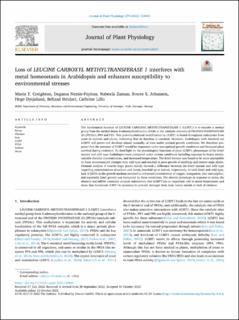| dc.contributor.author | Creighton, Maria Terese | |
| dc.contributor.author | Nemie-Feyissa, Dugassa | |
| dc.contributor.author | Zaman, Nabeela | |
| dc.contributor.author | Johansen, Sverre S. | |
| dc.contributor.author | Dysjaland, Hege | |
| dc.contributor.author | Heidariahootapeh, Behzad | |
| dc.contributor.author | Lillo, Cathrine | |
| dc.date.accessioned | 2023-03-30T13:28:01Z | |
| dc.date.available | 2023-03-30T13:28:01Z | |
| dc.date.created | 2022-12-05T13:17:02Z | |
| dc.date.issued | 2022 | |
| dc.identifier.citation | Creighton, M. T., Nemie-Feyissa, D., Zaman, N., Johansen, S. S., Dysjaland, H., Heidari, B., & Lillo, C. (2022). Loss of LEUCINE CARBOXYL METHYLTRANSFERASE 1 interferes with metal homeostasis in Arabidopsis and enhances susceptibility to environmental stresses. Journal of Plant Physiology, 279, 153843. | en_US |
| dc.identifier.issn | 0176-1617 | |
| dc.identifier.uri | https://hdl.handle.net/11250/3061220 | |
| dc.description.abstract | The biochemical function of LEUCINE CARBOXYL METHYLTRANSFERASE 1 (LCMT1) is to transfer a methyl group from the methyl donor S-adenosylmethionine (SAM) to the catalytic subunits of PROTEIN PHOSPHATASE 2A (PP2Ac), PP4 and PP6. This post-translational modification by LCMT1 is found throughout eukaryotes from yeast to animals and plants, indicating that its function is essential. However, Arabidopsis with knocked out LCMT1 still grows and develops almost normally, at least under optimal growth conditions. We therefore proposed that the presence of LCMT1 would be important under non-optimal growth conditions and favoured plant survival during evolution. To shed light on the physiological functions of plant LCMT1, phenotypes of the lcmt1 mutant and wild type Arabidopsis were compared under various conditions including exposure to heavy metals, variable chelator concentrations, and increased temperature. The lcmt1 mutant was found to be more susceptible to these environmental changes than wild type and resulted in poor growth of seedlings and rosette stage plants. Element analysis of rosette stage plants mainly showed a difference between the lcmt1 mutant and wild type regarding concentrations of sodium and boron, two-fold up or halved, respectively. In both lcmt1 and wild type, lack of EDTA in the growth medium resulted in enhanced concentration of copper, manganese, zinc and sulphur, and especially lcmt1 growth was hampered by these conditions. The altered phenotype in response to stress, the element and mRNA transcript analysis substantiate that LCMT1 has an important role in metal homeostasis and show that functional LCMT1 is necessary to prevent damages from heat, heavy metals or lack of chelator. | en_US |
| dc.language.iso | eng | en_US |
| dc.publisher | Elsevier | en_US |
| dc.rights | Navngivelse 4.0 Internasjonal | * |
| dc.rights.uri | http://creativecommons.org/licenses/by/4.0/deed.no | * |
| dc.title | Loss of LEUCINE CARBOXYL METHYLTRANSFERASE 1 interferes with metal homeostasis in Arabidopsis and enhances susceptibility to environmental stresses | en_US |
| dc.type | Peer reviewed | en_US |
| dc.type | Journal article | en_US |
| dc.description.version | publishedVersion | en_US |
| dc.rights.holder | The authors | en_US |
| dc.subject.nsi | VDP::Matematikk og Naturvitenskap: 400 | en_US |
| dc.source.pagenumber | 153843-? | en_US |
| dc.source.volume | 279 | en_US |
| dc.source.journal | Journal of plant physiology | en_US |
| dc.identifier.doi | 10.1016/j.jplph.2022.153843 | |
| dc.identifier.cristin | 2088770 | |
| cristin.ispublished | true | |
| cristin.fulltext | original | |
| cristin.qualitycode | 1 | |

